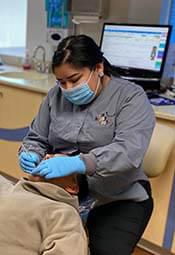Stick to your oral health routine even when you have braces
Your oral health is more important than ever when you’re wearing braces. After all, you’re taking a big step to improve the health and appearance of your smile, so why would you want to compromise the results by neglecting to take care of your teeth and gums? It’s relatively easy to keep brushing with braces on your teeth, but flossing can be a lot bigger challenge. Use the best practices we’ve outlined below to ensure you’re taking complete care of your teeth even when you have braces.
Effective Tips for Flossing with Braces
Use Ordinary Floss
Ordinary dental floss is still effective to use, just make sure that it is waxed and as thin as possible. Remove a section that is 12-18 inches long, and then thread one end behind the main wire of your braces. Continue threading until you have equal sections of floss above and below the wire, and then pull it into the space between your teeth. Focus on flossing the teeth rather than the wire itself, and avoid pulling outwards with force. Carefully pull the floss out, and repeat the process for each tooth.
Use a Floss Threader
A floss threader is a lot like the eye of a needle. This simple tool makes it a lot easier to get a piece of floss into the tight spaces you have to work with without skinning your knuckles up in the process. Flossing with braces can take up to three times longer than normal, but a floss threader does a lot to speed the process back up.
Use a Waterpik
These devices should not be used as an alternative to flossing but can serve as a great complement. Waterpiks shoot a thin stream of water at high pressure into the spaces between your teeth. Since you don’t have to navigate around the wires of your braces you can reach areas that are difficult to effectively reach otherwise. Waterpiks are available at most drugstores for around $50.
Use Another Method
If none of the methods mentioned above meets your needs you have a few more options:
- Dental Tape – If normal flossing hurts your gums, this thin, smooth tape might be the solution. Use it in the same way, that you use ordinary floss.
- Proxy Brush – These tiny brushes are small enough to get behind your braces wire quickly but shouldn’t be used as an alternative to floss. Talk to your dentist if you have trouble finding one.
- Orthodontic Brush – Kind of like a toothbrush with V-shaped bristles, these special brushes are the tool of choice for actual orthodontists. Again, however, they are meant to supplement rather than replace regular flossing.
Get the Most from Your Braces with MyOrthodontist
Having braces doesn’t have to be a negative experience. With the right team of doctors on your side, you can minimize the cost, pain, and stigma of braces and produce a better outcome overall. Connect with that team by contacting MyOrthodontist location nearest you.
Get Advice and Guidance from MyOrthodontist
Getting braces put on your teeth is not the end of the process, it’s just the start. You will need to see an orthodontist regularly, and you’re likely to have some questions along the way. Get all the help you need before, during, and after your braces are on from the team at MyOrthodontist.


